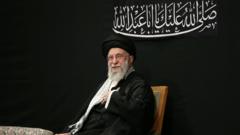Iran's Supreme Leader Ayatollah Ali Khamenei made his first public appearance since the initiation of the conflict with Israel, as reported by state media. Footage aired on Iranian state television captured him interacting with worshippers at a mosque on Saturday, ahead of the Shia Ashura festival. Prior to this event, Khamenei's last public communication had been a recorded address during the hostilities, which erupted on June 13, leading to the deaths of significant Iranian military figures and nuclear scientists due to Israeli strikes on Iran's crucial facilities.
In the backdrop of an explosive 12-day war in which Israel conducted surprise attacks targeting Iranian military and nuclear sites, Khamenei had only appeared in three video messages, which led to much speculation about his safety and whereabouts, with rumors suggesting he was underground. His recent appearance received extensive coverage in Iranian media, highlighting a sea of supporters visibly expressing joy at seeing their leader back on screen. During the event at Tehran's Imam Khomeini Mosque, Khamenei encouraged senior cleric Mahmoud Karimi to lead renditions of the patriotic anthem, “O Iran,” a song that gained prominence during the conflict.
As mourning rituals take place for the predominantly Shia Muslim nation during Muharram, Khamenei's resurgence in the public eye holds significant symbolic value. The 10th day of Muharram, Ashura, falls on July 6 this year and commemorates the martyrdom of Hossein, the grandson of the Prophet Muhammad. In a pre-recorded message on June 26, Khamenei proclaimed Iran's unwavering resistance against Israel, disregarding U.S. President Donald Trump’s calls for the nation to capitulate. The American military also engaged in the conflict, launching strikes on Iranian nuclear facilities on June 22, involving over 125 military aircraft and resulting in extensive damage. Iran's judiciary reported that the 12-day conflict resulted in over 900 deaths. As tensions continue to mount, the future of Iran's stance in the volatile geopolitical landscape remains uncertain.



















